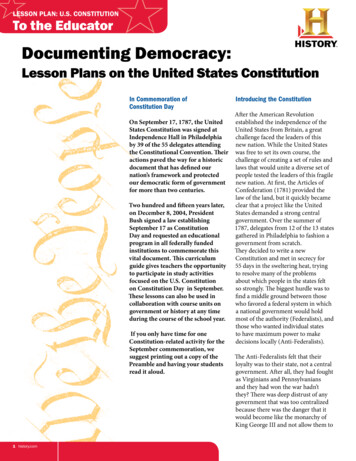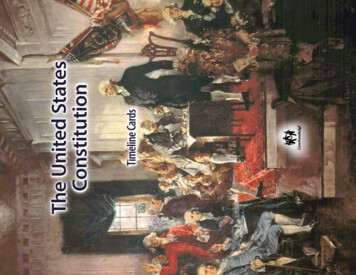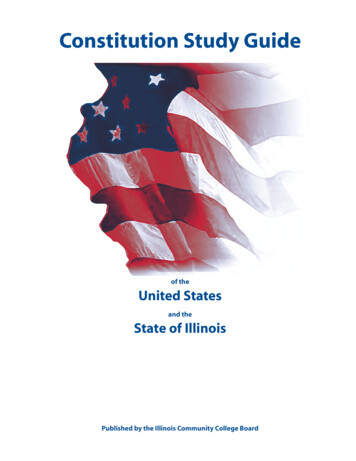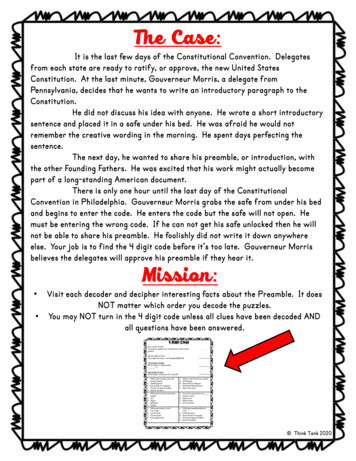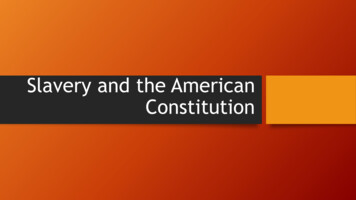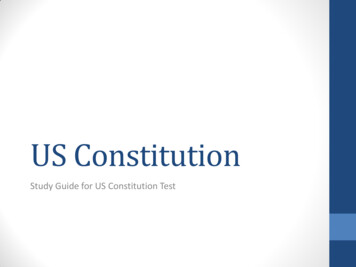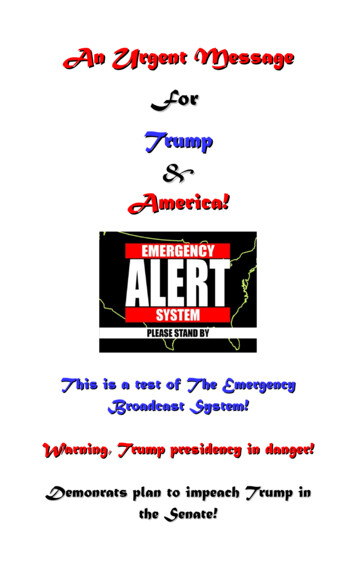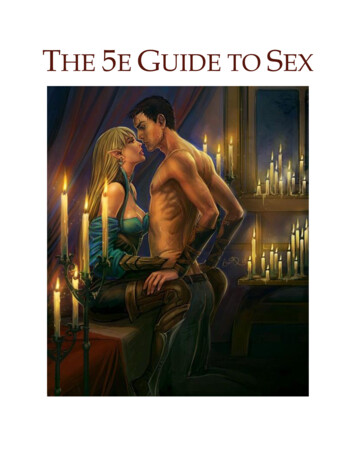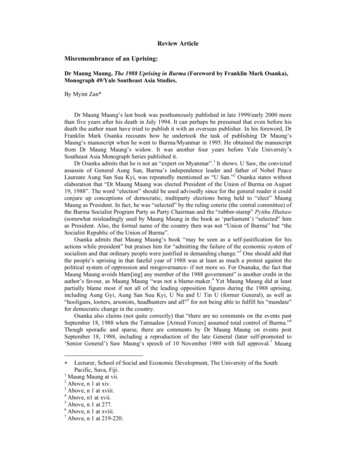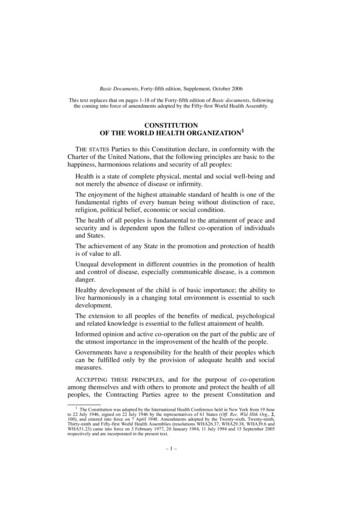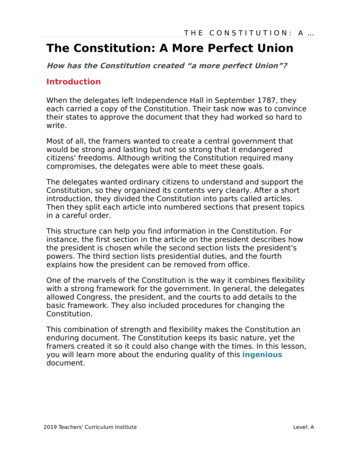
Transcription
T H E C O N S T I T U T I O N : A .The Constitution: A More Perfect UnionHow has the Constitution created “a more perfect Union”?IntroductionWhen the delegates left Independence Hall in September 1787, theyeach carried a copy of the Constitution. Their task now was to convincetheir states to approve the document that they had worked so hard towrite.Most of all, the framers wanted to create a central government thatwould be strong and lasting but not so strong that it endangeredcitizens' freedoms. Although writing the Constitution required manycompromises, the delegates were able to meet these goals.The delegates wanted ordinary citizens to understand and support theConstitution, so they organized its contents very clearly. After a shortintroduction, they divided the Constitution into parts called articles.Then they split each article into numbered sections that present topicsin a careful order.This structure can help you find information in the Constitution. Forinstance, the first section in the article on the president describes howthe president is chosen while the second section lists the president'spowers. The third section lists presidential duties, and the fourthexplains how the president can be removed from office.One of the marvels of the Constitution is the way it combines flexibilitywith a strong framework for the government. In general, the delegatesallowed Congress, the president, and the courts to add details to thebasic framework. They also included procedures for changing theConstitution.This combination of strength and flexibility makes the Constitution anenduring document. The Constitution keeps its basic nature, yet theframers created it so it could also change with the times. In this lesson,you will learn more about the enduring quality of this ingeniousdocument.2019 Teachers' Curriculum InstituteLevel: A
T H E C O N S T I T U T I O N : A .Level: A2019 Teachers' Curriculum Institute
T H E C O N S T I T U T I O N : A .Social StudiesVocabularychecks and balancesexecutive branchfederalisminterest groupinterstate commercejudicial branchjudicial reviewlegislative branchmajority rulepopular sovereigntyseparation of powers1. The Preamble Tells the Goals of GovernmentThe delegates who crafted the Constitution chose each word carefully.Some of their best-known words are in the introduction, called thePreamble, which explains the reasons for the new government.The Constitution begins with the memorable phrase “We the People.”With these words, the delegates announced that the Constitution basedits authority on the people themselves rather than on the authority ofthe states, the existing government, or a sovereign (ruler) appointed byGod. Instead, the power came from ordinary Americans. This concept isknown as popular sovereignty.The delegates also included a list of goals for the new government inthe Preamble, which addressed their want to “form a more perfect2019 Teachers' Curriculum InstituteLevel: A
T H E C O N S T I T U T I O N : A .Union.” What did the delegates mean by this? They wanted the statesto cooperate with each other and create a strong relationship betweenthe states and the national government.The Constitution also aims to “establish Justice.” Americans did notwant to be ruled by the might of soldiers or the decisions of kings. Theyinstead wanted to be ruled by laws that would apply to all peopleequally.The delegates hoped that the new government would “insure domesticTranquility.” By domestic, they meant within the country. Bytranquility, they meant peace and order. It was the government'sresponsibility to keep peace and maintain order within the country.The new government would “provide for the common defence.” Inother words, the national government would be responsible forprotecting the nation against foreign enemies, allowing for strongerprotection than would be possible if each state had its own army andnavy.The delegates wanted the new government to “promote the generalWelfare.” This meant that the government could support an economyand a society in which people could prosper.Finally, the delegates hoped to “secure the Blessings of Liberty toourselves and our Posterity.” By posterity, the delegates meant thegenerations that would come after them. They wanted the governmentto protect the freedoms gained in the American Revolution andpreserve them for Americans to enjoy in the future.The delegates knew that these goals required a national government.However, based on their experience with a king, many people weresuspicious of a strong central government. For this reason, thedelegates tried to create a balanced framework that people could trust.Level: A2019 Teachers' Curriculum Institute
T H E C O N S T I T U T I O N : A .2. The Legislative Branch Makes LawsFor the framers of the Constitution, the first step in building a trustedgovernment was to create a fair way to make laws. Article I of theConstitution gives the power to make laws to the legislative branch ofgovernment.The Structure of Congress The Constitution creates a bicameral, ortwo-part, national legislature called Congress. The two parts, or houses,of Congress are the House of Representatives and the Senate.Members of the Senate serve six-year terms so that they can enjoysome independence from the day-to-day opinions of voters. In contrast,members of the House serve two-year terms. As a result, they have toface the voters much more often. In this way, the framers tried tobalance the independence and thoughtfulness of the Senate with theHouse's responsiveness to the changing wishes of the voters.The framers also designed Congress to balance the rights of large andsmall states, so while every state gets two senators, representation in2019 Teachers' Curriculum InstituteLevel: A
T H E C O N S T I T U T I O N : A .the House is based on population. States with more people have morerepresentatives in the House. To determine the number ofrepresentatives for each state, the Constitution calls for a census (acount of the population) to be conducted every ten years. In time, thenumber of representatives in the House was set at 435, divided amongthe states based on their population.The framers considered the Senate to be the “upper house” of thelegislature, meaning that its members are supposed to be wiser andmore experienced than members of the “lower house.” For this reason,senators must be at least 30 years old and citizens for nine years, whileHouse members only have to be 25 and citizens for seven years.Originally, the Constitution allowed state legislatures to choose the twosenators to represent their state. Today, however, senators are electedby popular vote (direct vote by the people).How Congress Makes Laws The primary job of Congress is to makelaws. Any member of the House or Senate has the power to submit abill, or proposal for a new law, but only the House can propose newtaxes. If a majority in one house votes in favor of the bill, it is sent tothe other house for debate. If both houses approve the bill, it goes tothe president, who may then choose to sign or veto the law.Although the president can veto any proposed law, Congress canoverride the president's veto, which means passing the bill over thepresident's objections. However, overriding this presidential powerrequires a two-thirds majority in both houses.The Powers of Congress Article I elaborates on the other powers ofCongress. For example, only Congress can decide how to spend themoney raised through taxes. Other congressional powers include thepower to raise an army and navy, to declare war, to pay governmentdebts, and to grant citizenship.In addition, Congress may “make all Laws which shall be necessary andproper” to carry out its other powers. This power, known as the ElasticClause, gives Congress the flexibility needed to do its job. Over theyears, the Elastic Clause has been stretched to allow Congress to domany things that were never listed among its powers in theConstitution.Level: A2019 Teachers' Curriculum Institute
T H E C O N S T I T U T I O N : A .3. The Executive Branch Carries Out the LawsA government needs people to carry out, or execute, the laws passedby the legislature. For instance, when Congress approves a tax,someone must collect the money. If Congress appropriates, or setsaside, money for low-cost housing, someone must build and managethe housing.2019 Teachers' Curriculum InstituteLevel: A
T H E C O N S T I T U T I O N : A .Article II of the Constitution describes the branch of government thatfills this role, the executive branch. The head of the executive branchis the president, who is often called the chief executive.Electing the President Delegates at the Constitutional Congresswere not prepared to let the people elect the president directly. Instead,they decided that the president would be selected by a group ofelectors. Each state would have the same number of electors as it hadrepresentatives and senators in Congress. To win the presidency, acandidate needs a majority of the electoral vote.The president serves a four-year term. Under the Twenty-secondAmendment, a president may be reelected only once. Each newpresident makes a solemn promise called the oath of office. TheConstitution gives the exact words of the oath and calls for thepresident to “defend the Constitution.” These words reinforce theimportance of the Constitution as the basic law of the land.A president must be a natural-born American citizen and at least 35years old. The Constitution always refers to the president as “he”because the delegates to the Constitutional Convention probablyassumed that only men would ever vote or hold office. However,nothing in the Constitution prevents a woman from being electedpresident.The Powers of the President In addition to carrying out lawspassed by Congress, the president is commander in chief of thenation's military forces. He or she can, with the consent of the Senate,make treaties, or formal agreements, with other nations. The presidentnominates, or recommends, ambassadors (official representatives toother countries) and Supreme Court justices (judges). Finally, thepresident can grant pardons to people convicted of violating federal, ornational, laws.The framers expected that the executive branch would needorganizations, called departments, to carry out its duties. For example,the State Department handles relations with other nations. The JusticeDepartment is involved in law enforcement as well as court actions. Theheads of executive departments are members of the president'scabinet, a formal group of advisers.Today, the executive branch has over a dozen executive departments.Each executive department contains smaller, specialized agencies. Forinstance, the Department of Health and Human Services contains theFood and Drug Administration, which works to ensure that foods andLevel: A2019 Teachers' Curriculum Institute
T H E C O N S T I T U T I O N : A .medicines meet safety standards that have been set by Congress.Removing the President The Constitution gives Congress the powerto remove a president or other officials from office if they commitcertain crimes related to their duties. The House of Representatives canvote to impeach the president. To impeach means to formally accusethe president of the crimes specified in the Constitution. These crimesinclude “Bribery, or other high Crimes and Misdemeanors.” When theHouse votes to impeach, the Senate puts the president on trial, with thesenators serving as the jury, and if found guilty, the president isremoved from office.2019 Teachers' Curriculum InstituteLevel: A
T H E C O N S T I T U T I O N : A .4. The Judicial Branch Interprets the LawThe framers intended for the Constitution to be the “supreme Law ofthe Land,” meaning that no other laws or actions by the government orby any state can conflict with the Constitution. Protecting theConstitution is one of the principal responsibilities of the third branch ofgovernment, the judicial branch, which consists of the system offederal courts and judges.Article III of the Constitution gives the basic framework of the judicialbranch and establishes the country's highest court, the Supreme Court.It also gives Congress the power to create inferior (lower) courts tomeet the nation's needs.Federal courts also have the power to resolve disputes that involvenational laws, the federal government, or the states. People accused ofbreaking national laws can be tried in federal courts.Federal Court System Congress has authorized two main sets ofinferior federal courts. These lower courts are called district courts andLevel: A2019 Teachers' Curriculum Institute
T H E C O N S T I T U T I O N : A .appellate courts.Most cases involving federal laws are first heard in district court. TheUnited States is divided into large geographic districts, with eachdistrict covering several states. Citizens can appeal decisions given indistrict court, which means asking a higher court to review the case.Courts that review cases are called courts of appeal or appellate courts,and they consider only whether the original trial was fair and legal. Adecision by an appellate court can be appealed to the Supreme Court.The Powers of the Supreme Court The Supreme Court is the laststop in the judicial system. Its decisions are final, and they are bindingon all lower courts. Although the Constitution does not specify the sizeof the Supreme Court, Congress has set the size at nine members, whoare called justices. The Constitution says that all federal judges,including Supreme Court justices, serve for “good Behaviour,” whichmeans that once they are appointed, justices usually serve on the Courtfor life.A dispute goes directly to the Supreme Court only if it involves a stateor an ambassador from another country. Any other case comes to theSupreme Court after a trial and an appeal in lower courts. Participantsin either national or state courts may eventually appeal cases to theSupreme Court.Every year, lawyers ask the Supreme Court to review thousands ofcases, but the Court agrees to consider only about a hundred. TheSupreme Court usually reviews a case only if the justices think thedecision made by a lower court might conflict with the Constitution or afederal law. After hearing statements from both sides, the justicesdebate among themselves and vote. Supreme Court decisions, whichguide later decisions in lower courts, are announced and explained inwriting.Early in its history, the Supreme Court defined the power of judicialreview in Marbury v. Madison. This is the power to decide whether lawsand acts made by the legislative and executive branches conflict withthe Constitution. Courts all over the country rely on the Supreme Courtfor guidance about what is constitutional. Judicial review gives theSupreme Court great power in its role of protecting the “supreme Lawof the Land.”2019 Teachers' Curriculum InstituteLevel: A
T H E C O N S T I T U T I O N : A .5. Checks and Balances Between the BranchesThe framers of the Constitution were very concerned about achieving abalance between a strong national government and protection forindividual freedoms. They hoped that dividing the federal governmentinto three branches was one way to limit the government's power. Thisseparation of powers was a key part of the framers' vision of limitedgovernment, but what would keep one branch from dominating theothers? As one delegate to the Constitutional Convention pointed out,“From the nature of man, we may be sure that those who have power intheir hands . . . will always, when they can . . . increase it.”Because of this concern, the framers developed a system that wouldenable each branch of the government to limit the power of the othertwo branches. This system is called checks and balances.Checking the Power of Other Branches Checks allow one branchof government to block the actions of another branch. For instance, thepresident can check Congress's power to pass laws by vetoing a billbefore it becomes a law. In turn, Congress can check the president'spower by overriding the veto by a two-thirds majority vote in eachhouse.Level: A2019 Teachers' Curriculum Institute
T H E C O N S T I T U T I O N : A .Similarly, the judicial branch can check the actions of the other twobranches through its power of judicial review. The Supreme Court canoverturn a law, a treaty, or an executive action if the Court declaresthat it is unconstitutional.Balancing the Power of Other Branches Balances allow eachbranch of the government to have some role in the actions and powerof the other branches. For instance, judges, ambassadors, and cabinetmembers are appointed only if the president nominates them and theSenate approves the nomination. Similarly, the president has the powerto sign treaties, but they take effect only if the Senate approves them.The powers of the judicial branch are also balanced against the powersof the other two branches. Even though the Supreme Court can declarelaws unconstitutional, it is the president who chooses federal judges—and the Senate must approve these appointments. In addition,Congress can impeach federal judges. In these ways, the legislative andexecutive branches have some role in the actions of the judicial branch.These checks and balances keep any one branch of the federalgovernment from being too strong. This balance of powers is one of themost important features of the U.S. system of government.2019 Teachers' Curriculum InstituteLevel: A
T H E C O N S T I T U T I O N : A .6. The Amendment ProcessThomas Jefferson believed that “the earth belongs to the living and notto the dead.” When drafting the Constitution, the framers kept thisbelief in mind because they knew that the Constitution would need tobe changed over time to include new ideas from each new generation.At the same time, they wanted the Constitution to provide a lasting andstable framework for the government, so they made changing theConstitution possible but difficult.Changing the Constitution Article V describes two ways in whichchanges, called amendments, can be added to the Constitution.Congress may propose an amendment with a two-thirds vote in eachhouse of Congress. A national convention, called by Congress at therequest of at least two-thirds of the state legislatures, may alsointroduce an amendment proposal. Thus, either Congress or the statescan start the process of amending the Constitution.After an amendment is proposed, it must be ratified before it canbecome part of the Constitution. The Constitution gives two ways ofLevel: A2019 Teachers' Curriculum Institute
T H E C O N S T I T U T I O N : A .ratifying an amendment. It may be approved by the legislatures in atleast three-fourths of the states, or it may be ratified by specialconventions in at least three-fourths of the states. Once an amendmenthas been approved, it becomes part of the Constitution.Amendments So Far Over the years, people have suggested morethan 10,000 amendments to the Constitution, but only 27 have beenapproved. The first ten amendments were added almost immediatelyafter the Constitution was ratified. These amendments were demandedby many Americans in exchange for their support of the Constitution.Called the Bill of Rights, these ten amendments primarily guaranteespecific rights to citizens.The other 17 amendments became part of the Constitution one at atime. Some of them changed the way certain public officials are elected,while others guaranteed the rights of certain groups of Americans. TheThirteenth Amendment made slavery illegal. The NineteenthAmendment guaranteed women the right to vote. The Twenty-sixthAmendment gave the right to vote to all citizens over the age of 18.7. The Federal System Connects the Nation and the StatesThe framers of the Constitution wanted a strong national government,but they also wanted the states to keep significant powers. They2019 Teachers' Curriculum InstituteLevel: A
T H E C O N S T I T U T I O N : A .accomplished both goals by creating a federal system of government inwhich power is shared between the national and state governments.Powers Belonging to the National Government The Constitutiongives some powers only to the national government. In general, theseare powers best exercised by one central authority, such as declaringwar and making treaties. The Constitution also says that only thenational government can print and coin money since the framers hadlearned from experience that separate state currencies made no sense.Similarly, Article I gives Congress the power “to regulate Commercewith foreign Nations, and among the several States, and with the IndianTribes.” Known as the Commerce Clause, this provision gives thenational government the power to regulate interstate commerce. Forexample, under the Articles of Confederation, many states tried toprotect their own industries by taxing goods imported from otherstates, threatening interstate trade. The Commerce Clause preventedthis and made the entire United States a common market, or free-tradezone.There were several advantages to giving states a common market andcommon coinage. First, goods and resources could flow more easilyacross the country, which is important because different regions dodifferent things well. New Englanders might be very good at makingcloth, but their region is not good for growing cotton, while Southernersmight have lots of cotton but few factories for turning it into cloth.Making interstate trade easier for cloth makers and cotton growershelps both businesses thrive.Second, the common market made it easier to create large businessesthat crossed state lines. This was very important to companies likethose that built the nation's railroads in the 19th century.Third, the common market helped to create a single national economy.Under the Articles of Confederation, it was almost as if the country had13 small economies. These could never have grown as diverse orpowerful as the U.S. economy did.Notice that the Commerce Clause also gives the national governmentthe right to regulate trade with Indian tribes. In effect, the Constitutiontreats native tribes as foreign governments, and relations with these“nations within a nation” are the responsibility of Congress, not thestates.Powers Belonging to the StatesLevel: AThe Constitution does not spell2019 Teachers' Curriculum Institute
T H E C O N S T I T U T I O N : A .out specific powers of the states, but instead says that the statesretain, or keep, any powers that are not given to the nationalgovernment. For instance, the Constitution says nothing about schools,marriage, establishing local governments, licensing doctors andlawyers, or most crimes. The states make the laws in these areas of lifeas long as it does not interfere with rights spelled out in theConstitution.Article IV of the Constitution does, however, outline the responsibilitiesof states to each other and says that each state must give “full Faithand Credit” to the laws and court decisions of other states, whichmeans accepting other states' laws and court decisions as legal. Forexample, a driver's license issued in one state is legal in every state.Similarly, states must obey legal contracts that people have made inother states. Like the Commerce Clause, the Full Faith and CreditClause brings stability to business dealings. States are also required tohelp each other track down fleeing criminals, so criminals cannotescape justice by fleeing to another state.Finally, the Constitution does not allow one state to discriminateunreasonably against a citizen of another state. A state may not, forexample, refuse to let a child who was born in another state attend itspublic schools.Shared Powers Federal and state governments also share somepowers. For example, both levels of government can collect taxes, buildroads, borrow money, and regulate education.If you think federalism, or the sharing of power, sounds complicated,you are right. During presidential elections, Congress sets the date fornational elections, while the states register voters and run theelections. States count the ballots, while the national governmentorganizes the Electoral College vote, which determines who will bepresident.Federalism is also complicated because the Constitution provides only ageneral framework for the sharing of powers. There was no way for theframers to spell out rules for every possible situation. The federalsystem continues to evolve through new laws, court decisions, andconstitutional amendments.The Law of the Land Americans may disagree about how tointerpret the Constitution, but they may not ignore it. Article VI statesthat the Constitution and the laws flowing from it are the “supreme Lawof the Land,” which means that a state's constitution, laws, and judicial2019 Teachers' Curriculum InstituteLevel: A
T H E C O N S T I T U T I O N : A .decisions must agree with the Constitution and must not conflict withany other federal laws or treaties. In addition, everyone who holds astate or federal office must promise to support the Constitution.Level: A2019 Teachers' Curriculum Institute
T H E C O N S T I T U T I O N : A .8. Popular Participation in GovernmentThe framers of the Constitution designed a government based on thewill of the people. They expected people to take part in their owngovernment and to hold leaders responsible for their actions.For government to reflect the popular will, it makes sense for itsdecisions to be based on what most people want, which is why theConstitution establishes the principle of majority rule. For example,laws are passed in Congress by majority vote, and elections aredecided by a majority of voters.It is through elections that most people participate in the government.Leaders must listen to the voters, or they will not be elected (orreelected), meaning that elections serve the vital function ofexpressing the will of the people.But who exactly are “the people”? The framers did not specify whowould have the right to vote, and over the years, states establishedvarious requirements for voting. It took many years of struggle to2019 Teachers' Curriculum InstituteLevel: A
T H E C O N S T I T U T I O N : A .establish the principle that all citizens should have the right to vote.Women, for example, were not guaranteed this right until theNineteenth Amendment was ratified in 1920.Popular participation in government has evolved in other ways that arenot part of the Constitution. For example, the Constitution makes nomention of political parties, but parties today select most candidatesfor political office. Becoming active in party affairs is another way thatvoters can help choose their leaders and influence the positions theytake on issues.People also take part in government indirectly through interestgroups. There are interest groups for almost any issue that peoplemight care about. Some interest groups represent groups such asbusinesses, industries, and workers. Others represent groups of people,such as churchgoers, women, or minorities. Some are even organizedaround issues, such as the environment or health care.Interest groups influence government in several ways. They rally publicopinion, work to elect candidates who promise to listen to them, and tryto persuade lawmakers and government officials to take actions theyfavor.If the framers were alive today, they might be surprised to see thechanges in the system they created. Yet the remarkable thing is howsuccessful they were in building the basic framework of Americandemocracy. As one historian has said, the Constitution “would becomethe rule of life for a country larger than any of the founders imagined,and would last longer than most of them dared hope.”Level: A2019 Teachers' Curriculum Institute
T H E C O N S T I T U T I O N : A .Lesson SummaryIn this lesson, you learned how the Constitution met thedelegates' goal of creating “a more perfect Union.”The Preamble As the first words of the Preamble tell us, theConstitution's authority comes directly from the people, not the states.This concept is known as popular sovereignty. The Preamble goes on tolist the goals of the new government.The Legislative Branch Article I of the Constitution creates abicameral Congress with a House of Representatives and a Senate.Every state is represented by two senators and a number ofrepresentatives based on the state's population. Congress's primary jobis to make laws.The Executive Branch Article II creates the executive branch, which isheaded by the president. The president serves a four-year term andmay be reelected once. The president carries out laws passed byCongress. Other powers of the president include making treaties andappointing Supreme Court justices.The Judicial Branch Article III establishes the Supreme Court andgives Congress the power to create lower courts. Supreme Court2019 Teachers' Curriculum InstituteLevel: A
T H E C O N S T I T U T I O N : A .decisions are binding on all lower courts. The power of judicial reviewallows the Supreme Court to decide whether laws and actions by thelegislative and executive branches are unconstitutional.Checks and Balances The framers developed a system of checks andbalances that enables each branch of government to limit, or check, thepower of the other two branches. The Constitution provides checks andbalances in the powers of each branch.The Amendment Process Article V outlines the process by whichamendments can be made to the Constitution. Twenty-sevenamendments have been added. The first ten amendments form the Billof Rights.The Federal System The Constitution creates a federal system ofgovernment in which power is shared between the national governmentand the states.Popular Participation in Government Elections serve the vitalfunction of expressing the will of the people. People also participate ingovernme
The Constitution: A More Perfect Union How has the Constitution created “a more perfect Union”? Introduction When the delegates left Independence Hall in September 1787, they each carried a copy of the Constitution. Their task now was to convince their states to ap

